The second helicopter ever flown in the United States was the product of the
predecessor company of today 's Boeing Helicopters.
The machine was the PV 2, which acquired its designation from the name of the early firm -- the P - V
Engineering Forum which was founded by the legendary Frank Piasecki .
Boeing Helicopters is the rotorcraft division of the Boeing Company of Seattle, Washington (USA) one of the world 's leading manufacturer of large civilians jets aircraft and aerospace products and services. The tandem rotor design is a Boeing hallmark. By 1990, the company has built more than 2.500 aircraft in this configuration.
 1940 : P - V Engineering Forum PV 1
Piasecki 's first project was a NOTAR
class helicopter, but the time 1940 technology wasn't ready for
hat advancement yet and the machine was not built.
1940 : P - V Engineering Forum PV 1
Piasecki 's first project was a NOTAR
class helicopter, but the time 1940 technology wasn't ready for
hat advancement yet and the machine was not built.
 April 11, 1943 : P - V Engineering Forum PV 2
April 11, 1943 : P - V Engineering Forum PV 2
The second successful helicopter flown in the United States. The PV-2 was developed as a technology demonstrator.
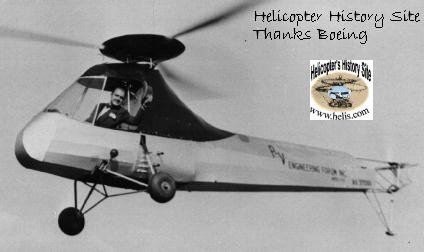 Frank Piasecki on the PV2
Frank Piasecki on the PV2
 March 7, 1945 : PV 3 Dog Ship (HRP-X/XHRP-1/HRP-1)
March 7, 1945 : PV 3 Dog Ship (HRP-X/XHRP-1/HRP-1)
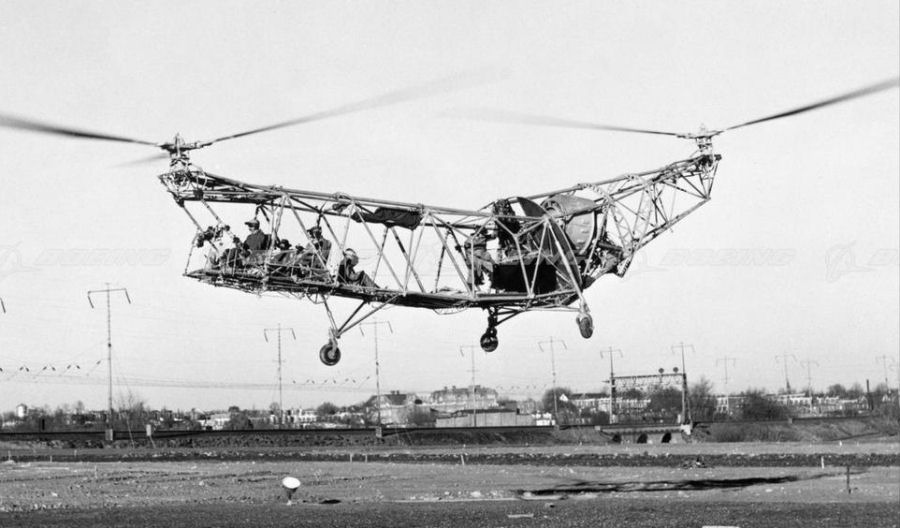
The first world's successful tandem-rotor Helicopter. A ten seats helicopter powered by a 600 hp Pratt & Whitney R-1340 engine. 28 units were built and served with the US Navy and Coast Guard. The very unusual bent fuselage earned it the nickname flying banana which stuck to this and the later Piasecki models.
XHRP stood for: "X" indicated that this was not a US Navy aircraft yet, but a company prototype. "R" Helicopter Transport ("T" was already taken for Trainer), and "P" for Piasecki. The official Navy prototypes fell under the XHRP-1 designation
 1946 :
The P-V Engineering Forum changed its name to
Piasecki Helicopter Corp.
1946 :
The P-V Engineering Forum changed its name to
Piasecki Helicopter Corp.
 1948 : Piasecki PV 14 (XHJP-1)
The HUP prototype
1948 : Piasecki PV 14 (XHJP-1)
The HUP prototype
 1950 : Piasecki PV 17 (HRP-2).
An HRP-1 variant with an all metal fuselage and a number
of refinements and modifications for the US marines. 5 built.
1950 : Piasecki PV 17 (HRP-2).
An HRP-1 variant with an all metal fuselage and a number
of refinements and modifications for the US marines. 5 built.
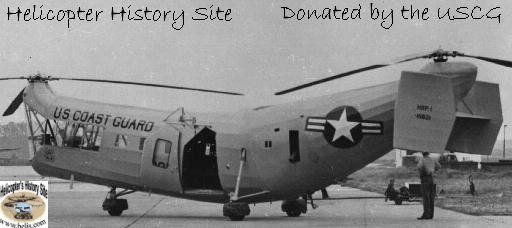
 1952 :
Piasecki PV 18 Retriever "HUP" / Mule (H-25)
1952 :
Piasecki PV 18 Retriever "HUP" / Mule (H-25)
 1953 :
Piasecki PD 22 Shawnee / Workhorse (H-21)
1953 :
Piasecki PD 22 Shawnee / Workhorse (H-21)
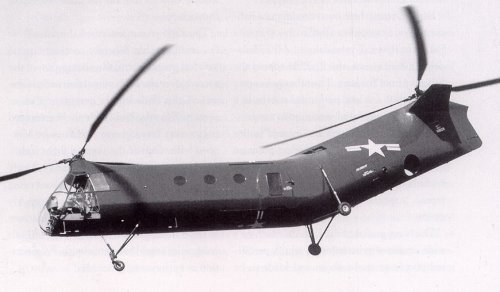
 1954 : Piasecki PV 15 Transporter ( H-16 / H-27 )
1954 : Piasecki PV 15 Transporter ( H-16 / H-27 )
A 40 passenger aircraft, it was the largest helicopter in the world at the time. The second unit produced was first designated H-27 and then H-16A
On Jan 5 1956, the sole Piasecki YH-16A Turbo Transporter prototype (BuNo 50-1270), breaks up in flight at ~1555 hrs and crashes near Swedesboro, New Jersey, near the Delaware River, while returning to Philadelphia, PA from a test flight over New Jersey. The cause of the crash was later determined to be the aft slip ring, which carried flight data from the instrumented rotor blades to the data recorders in the cabin. The slip ring bearings seized, and the resultant torque load severed the instrumentation standpipe inside the aft rotor shaft. A segment of this steel standpipe tilted over and came into contact with the interior of the aluminum rotor shaft, scribing a deepening groove into it. The rotor shaft eventually failed in flight, which in turn led to the aft blades and forward blades desynchronizing and colliding. The aircraft was a total loss, the two test pilots, Harold Peterson and George Callaghan, were killed. This led to the cancellation not only of the YH-16, but also the planned sixty-nine-passenger YH-16B version.
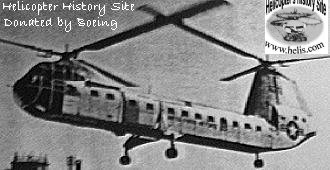
 1955 : Piasecki 42 / 43 / 44 / 63 / 71 [ Vertol 105 ]
Commercial developments of the H-21
1955 : Piasecki 42 / 43 / 44 / 63 / 71 [ Vertol 105 ]
Commercial developments of the H-21
 1956 : Rebrand to Vertol Aircraft Co.
1956 : Rebrand to Vertol Aircraft Co.
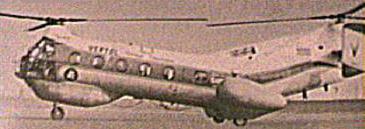
 1957 : Vertol 76 (VZ-2)
A research aircraft to investigate the tiltwing.
Complete it first successful conversion flight on July 15, 1958.
1957 : Vertol 76 (VZ-2)
A research aircraft to investigate the tiltwing.
Complete it first successful conversion flight on July 15, 1958.
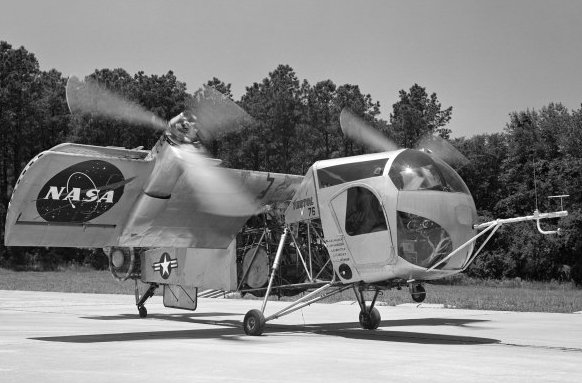
Boeing Helicopters is the rotorcraft division of the Boeing Company of Seattle, Washington (USA) one of the world 's leading manufacturer of large civilians jets aircraft and aerospace products and services. The tandem rotor design is a Boeing hallmark. By 1990, the company has built more than 2.500 aircraft in this configuration.
The second successful helicopter flown in the United States. The PV-2 was developed as a technology demonstrator.
 Frank Piasecki on the PV2
Frank Piasecki on the PV2

The first world's successful tandem-rotor Helicopter. A ten seats helicopter powered by a 600 hp Pratt & Whitney R-1340 engine. 28 units were built and served with the US Navy and Coast Guard. The very unusual bent fuselage earned it the nickname flying banana which stuck to this and the later Piasecki models.
XHRP stood for: "X" indicated that this was not a US Navy aircraft yet, but a company prototype. "R" Helicopter Transport ("T" was already taken for Trainer), and "P" for Piasecki. The official Navy prototypes fell under the XHRP-1 designation

A 40 passenger aircraft, it was the largest helicopter in the world at the time. The second unit produced was first designated H-27 and then H-16A
On Jan 5 1956, the sole Piasecki YH-16A Turbo Transporter prototype (BuNo 50-1270), breaks up in flight at ~1555 hrs and crashes near Swedesboro, New Jersey, near the Delaware River, while returning to Philadelphia, PA from a test flight over New Jersey. The cause of the crash was later determined to be the aft slip ring, which carried flight data from the instrumented rotor blades to the data recorders in the cabin. The slip ring bearings seized, and the resultant torque load severed the instrumentation standpipe inside the aft rotor shaft. A segment of this steel standpipe tilted over and came into contact with the interior of the aluminum rotor shaft, scribing a deepening groove into it. The rotor shaft eventually failed in flight, which in turn led to the aft blades and forward blades desynchronizing and colliding. The aircraft was a total loss, the two test pilots, Harold Peterson and George Callaghan, were killed. This led to the cancellation not only of the YH-16, but also the planned sixty-nine-passenger YH-16B version.



